
- •Lesson (1) Cell theory
- •Importance
- •Lesson (2) Cell ultra structure
- •L eucoplasts (White plastids)
- •Lesson (3) Differentiation of cells and diversity of plant and animal tissues
- •Lesson (4) Cell processes
- •Importance of stem cells:-
- •Importance of cell fractionation technique:-
- •Answer four questions only
Lesson (2) Cell ultra structure
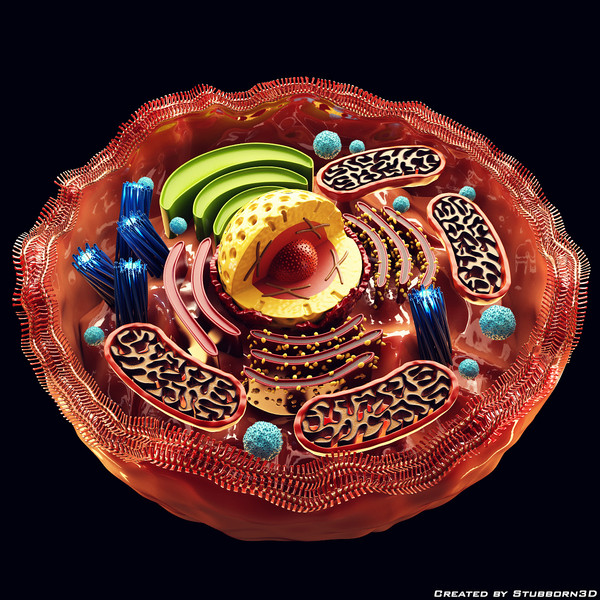
Cell is the functional and structural unit of living organisms, it can reproduce, respond to environment, and even respire!!
![]()
Cell is composed of a protoplasmic substance surrounded by cell membrane
Protoplasm consists of cytoplasm and nucleus.
Cells are divided into:-
1- Animal cells
2- Plant cells
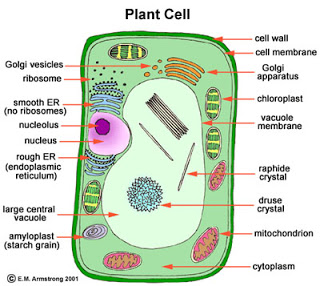
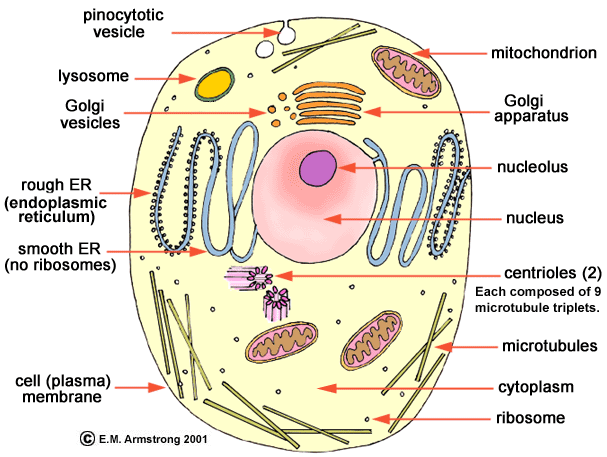
Fig. (5) Structure of animal cell Fig. (6) Structure of plant cell
![]()
The cells of some bacteria, fungi, plants and algae are surrounded by a wall of Cell wall.
Cell walls have holes and made up of cellulose fibres, which makes substances and water pass through them easily.
Function of cell walls:-
They support and protect plant cells, and give them their definite shapes.
![]()
Definition: A thin membrane which surrounds the cell, it separates between the cell components and its external medium.
Function:-
1- It organizes the passage of substances to and from the cell.
2- It prevents the spread of cytoplasm outside the cell.
Structure:-
Cell membrane is composed of phospholipid bi- layer. The hydrophilic heads (heads which can dissolve in water) of these molecules face the aqueous medium outside cell, while the hydrophobic tails (tails which cannot dissolve in water) exist inside.
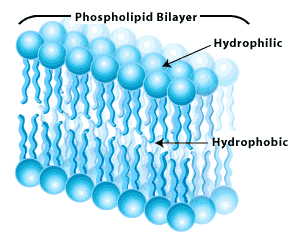
Fig. (7) Phospholipid bilayer in cells
There are some protein molecules between the two layer of phospholipids which work as:-
- Passages of the substances that enter and get out of the cell.
- Regions to identify the substances entering cells (such as hormones and nutrients)
Cell membrane is liquid (resembles oil in water) because the phospholipids forming it are in liquid state.
There are some cholesterol molecules bound to phospholipids in cell membrane to keep the membrane cohesive.
![]()
Definition: The largest and most obvious organelle in cell, it has a spherical or ellipsoidal shape.
Nucleus consists of:-
1- Nuclear membrane
A double layer which separates between the components of the nucleus and cytoplasm. It has nuclear pores through which substances pass between the nucleus and cytoplasm
2- Nucleoplasm
A jelly-like transparent fluid which contains some filaments coiled around each other called chromatins
3- Nucleolus
There might be more than one nucleolus in cells (especially those which are responsible for secreting proteins like enzymes and hormones)

Fig. (8) Structure of nucleus
Structure of chromosomes:-
During cell division process, chromatins condense forming chromosomes. Chromosomes appear at Metaphase stage during cell division process in the form of two threads (two chromatids) attached together at a point called centromere
Structure of chromatids
Chromatids are composed of DNA coiled around Histones proteins.
DNA carries the hereditary traits of living organisms, which are being inherited across generations by reproduction process
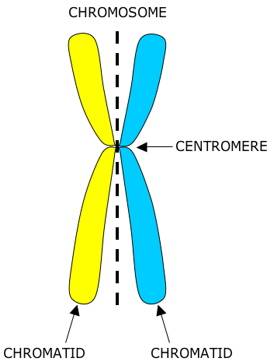
Fig. (9) Structure of chromosome
N.B: Chromosome (Word derived from Latin which means colour body) is called by this name because it is stained by basic dyes which makes it more obvious during cell division.
The importance of nucleus
1- It controls cell division process.
2- It contains the nucleolus which is responsible for forming ribosomes (which synthesize proteins).
![]()
Definition: A semi-fluid substance filling the space between the nucleus and cell membrane. It's composed of water and other organic and inorganic substances.
Cytoplasm contains group of microtubes and filaments called cytoskeleton, which:-
1- Supports the cell.
2- Works as passages for the transport of substances within cell
Cytoplasm also contains cell organelles, they are divided into:-
Membranous organelles: Organelles surrounded by membranes
Examples: Golgi bodies – endoplasmic reticulum – plastids - mitochondria – Vacuoles.
Non-membranous organelles: Organelles which are not surrounded by membranes
Examples: ribosomes and centrosomes.
1- Ribosomes
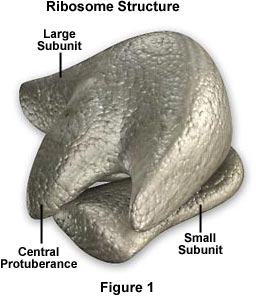 They are non-membranous
round organelles inside the cell which synthesize proteins, they
exist in two regions of the cell:-
They are non-membranous
round organelles inside the cell which synthesize proteins, they
exist in two regions of the cell:-
1- In Cytoplasm: They synthesize protein and send it
immediately to the cytoplasm to be used in growth and
renewal processes.
2- Attached to the external surface of endoplasmic
reticulum: They are more than those in cytoplasm, they
synthesize proteins which are send outside the cell
through the inner endoplasmic reticulum after modifying
them.
Fig. (10) Ribosome
2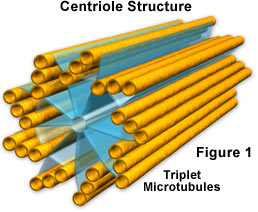 -
Centrosome
-
Centrosome
A structure which exists in animal cells (except
nerve cell). It is composed of two particles called
centrioles
There aren't any centrosomes in plant, algae
and most fungi cells, but instead, there are parts
of cytoplasm that carry out the functions of
centrosome.
Fig. (11) centrioles
Function:-
1- It plays an important role in cell division process because spindle fibres between the two centrioles extend between the poles of cell, which helps the cell split into two cells.
2- It forms cilia and flagella.
3- Endoplasmic reticulum
A group of membranous microtubes which permeate all parts of cytoplasm, it is connected with both plasma and nuclear membranes.
Function: It transports substances across all parts of cell and form nucleus to cytoplasm.
T ypes
of endoplasmic reticulum:-
ypes
of endoplasmic reticulum:-
Smooth Endoplasmic reticulum
It doesn't have any ribosomes, it works on:-
1- Synthesizing lipids in cells.
2- Changing carbohydrates into glycogen.
3- Changing the nature of some toxins to become
less poisonous
Fig. (12) Smooth endoplasmic reticulum
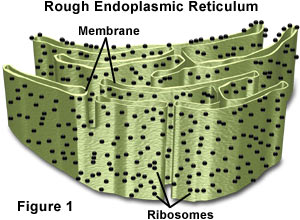
Rough Endoplasmic reticulum
It has a great no. of ribosomes, its works on
1- Synthesizing proteins in cells.
2- Modifying proteins produced by ribosomes
3- Producing new membranes for cells.
Fig. (13) Rough endoplasmic reticulum
4- Golgi body
A group of flat membranous sacs with spherical
ends.
F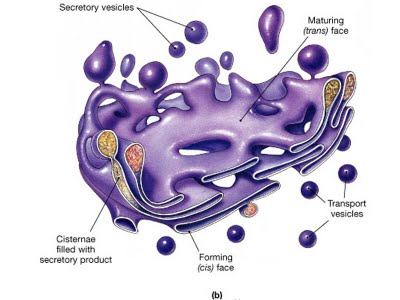 unction:-
unction:-
- It receives the substances produced by
endoplasmic reticulum through transport
vesicles. Then, it classifies these substances,
modify them, and send them to:-
- Parts of cells which may use them.
- Secretary vesicles which expel them from cell
in the form of secretions.
Fig. (14) Structure of Golgi body
(N.B: The no. of Golgi bodies inside cell differs according to the secretory acitivty of cell, The cells of glands have great no. Golgi bodies)
Golgi bodies were names after scientist "Camillo Golgi" who was the first to describe them in 1898.
Golgi bodies in plants and algae are called Dictyosomes
5- Lysosomes
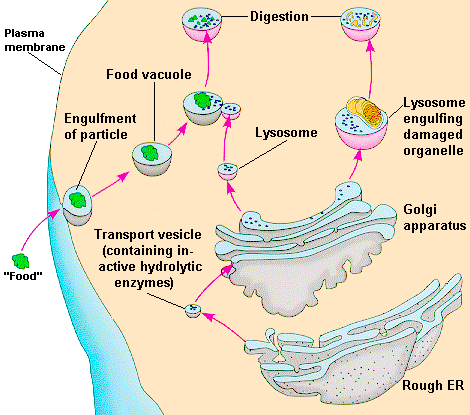
They are small spherical membranous
vesicles formed by Golgi bodies, they
contain digestive enzymes within them.
Function:-
1- Getting rid of useless old and destroyed
cells or organelles.
2- Digestion of nutrients being swallowed
by cells and breaking them to simple
substances.
White blood cells use Lysosomes in
killing microbes.
Fig. (15) Lysosomes function
Cell is not affected by the enzymes of Lysosomes because their enzymes are separated from the other components of cell by a membrane.
6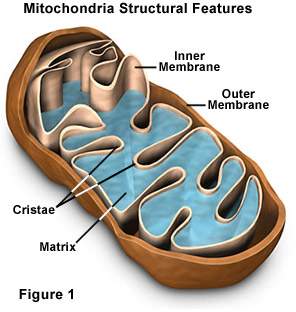 -
Mitochondria
-
Mitochondria
A sac-like membranous structure that exists
in all cells, it is composed of:-
1- Inner membrane
It includes folds in it called Cristae
2- Cristae
They are folds occurring in the inner membrane,
they increase the surface area of the medium of
chemical reactions occurring inside
mitochondria to speed them up
3- Outer membrane
Fig. (16) Structure of mitochondria
Function of mitochondria
1- It stores respiratory enzymes in the cell
2- It stores substances which are formed as a result of oxidation of nutrients such as glucose.
3- It stores the energy resulted from respiration process in the form of a compound called Adenosine Triphosphate (ATP) from which the cell can release energy again.
7- Vacuoles
They are small membranous sacs which exist in cells, they exist with great no. in animal cells, they can accumulate in one or more bigger vacuoles in plant cells.
Function: They store water, wastes and food till the cell use or get rid of them.
8- Plastids
They are membranous organelles which have different shapes and exist in plant cells, there are three kinds of plastids which are classified according to the kind of pigments in them, they are:-
